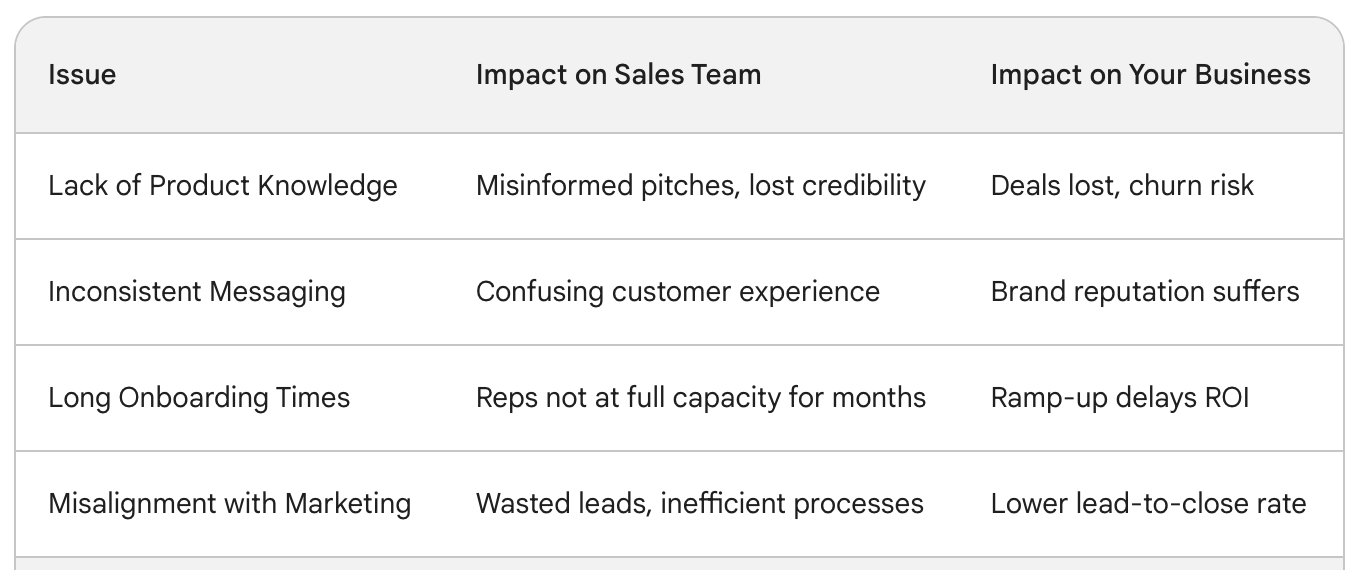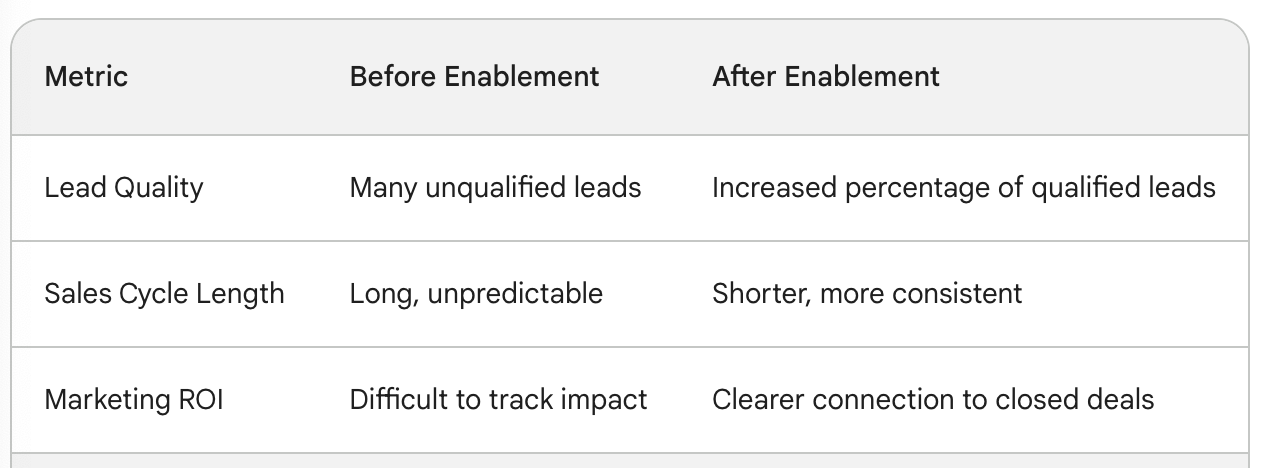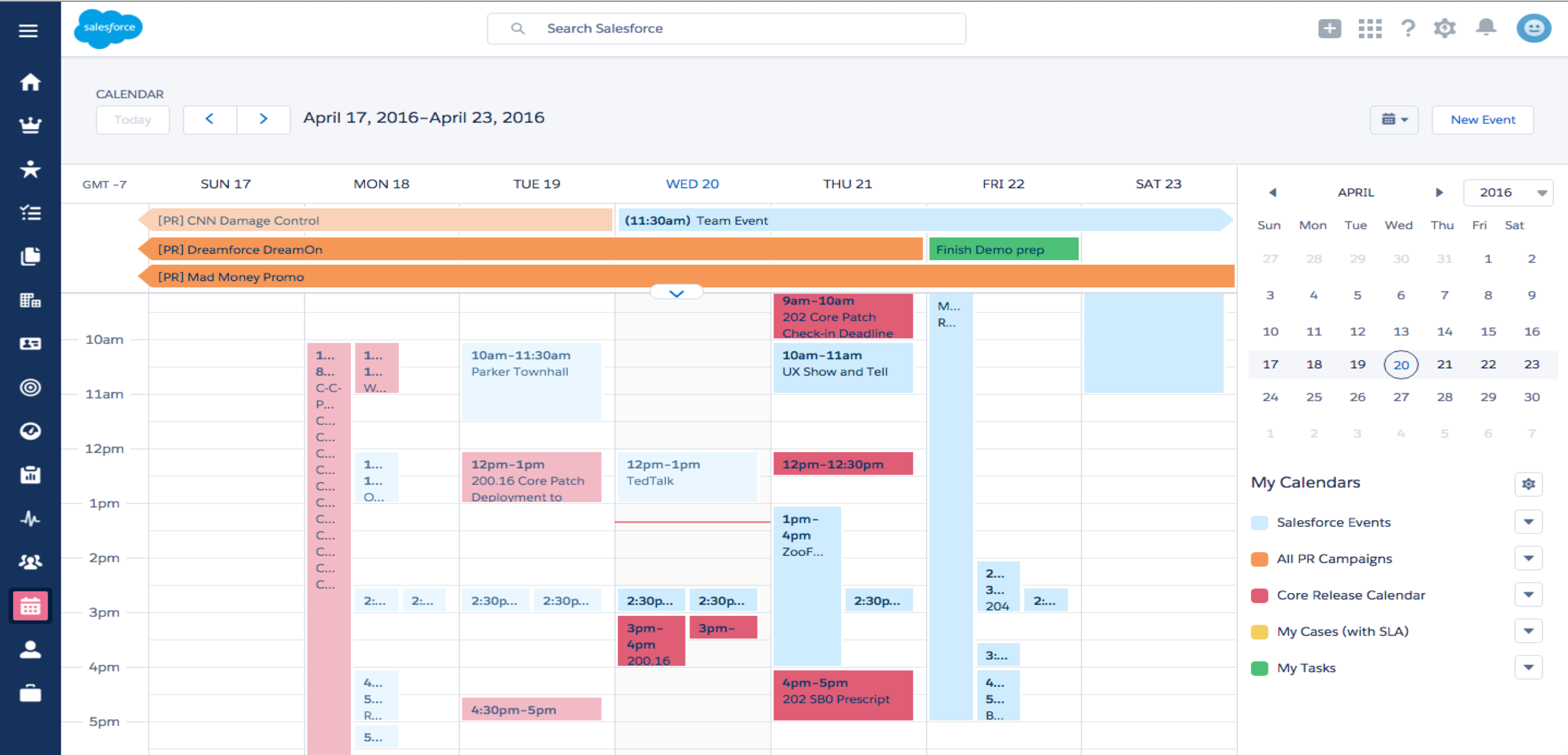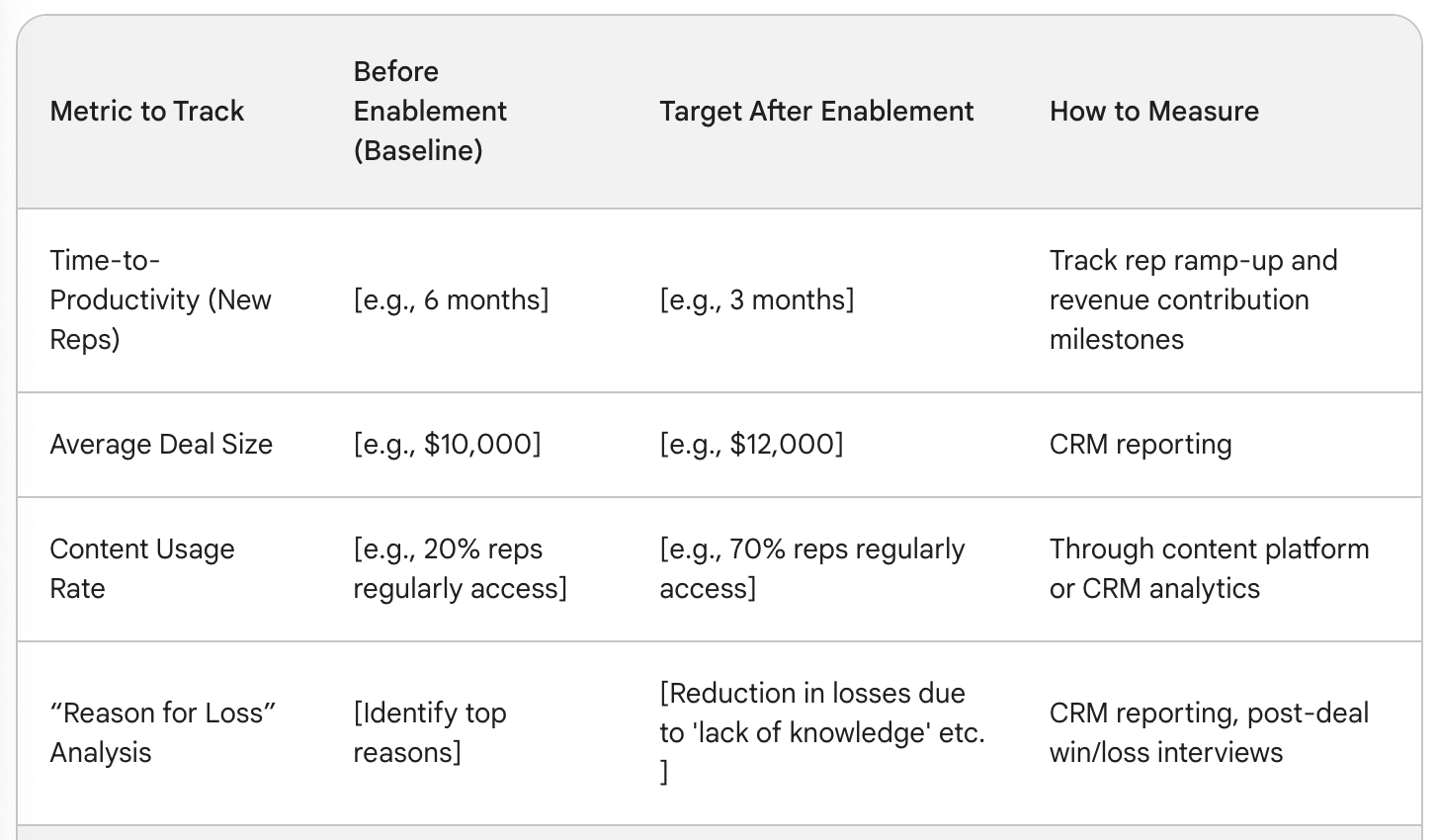Okay, be honest: how many times have you heard the term “sales enablement” and rolled your eyes just a little? I get it. It can feel like another corporate buzzword. But hear me out – after years in SaaS, I've seen firsthand how the right tools and knowledge can turn a struggling sales team into a revenue-generating powerhouse.
Trouble is, not everyone understands why investing in sales enablement is crucial, especially if you're like me and work in a marketing-driven organization. I get it. We marketers thrive on measurable ROI, and sometimes sales enablement can feel like that fluffy investment that doesn't directly translate into leads. But, here's the thing: it does translate to something even more powerful – closed deals.
So, how do you convince your CEO, your cross-functional partners, and maybe even yourself (we all have those doubts, right?) that sales enablement is worth the time, money, and effort?
Let's break it down.

The Cold, Hard Truth About Your Sales Team

I love my sales team. They're the engine pushing our product forward. But even the best teams have their challenges. Here's what I've come to realize through the years:
They're Drowning in Information
Product updates, competitor analysis, use cases, pricing changes... the volume of knowledge they need is insane. If they can't quickly find what they need when they need it, that's lost opportunity.
They're Reinventing the Wheel
Every new sales rep has a learning curve. But if there's no playbook, no centralized content, and no established best practices, that curve gets exponentially steeper. It's wasted time and a whole lot of inconsistent messaging.
They're Not Aligned with Marketing
Okay, here's where I get a bit feisty. We spend all this time and money on killer content, but does it make its way into the hands of our sales reps? Do they even know what our latest messaging is? If not, that's a serious misfire.
Picture This...
...A sales world where every rep is a walking encyclopedia of your product and value prop. They’re on-message, confident closers, and (here's the kicker) they're working with you, not against you.

Sales enablement is how you forge that dream team.
But I'm a Marketer – Why Should I Care?

Here's why a savvy marketer should be the champion of sales enablement:
Lead Quality Gets a Major Upgrade: Sales enablement means reps are better at identifying ideal customers and having the right conversations. That translates to higher quality leads filling your pipeline and, as a bonus, sales stops wasting time on dead-ends.
Closed Deals Happen Faster: Imagine a world where your sales cycles are streamlined. Armed with the right tools and knowledge, reps can close those deals, which is ultimately what every marketer measures success on.
You Become the Hero: Enablement is all about providing value. When your sales team starts rocking it because of the support you provide, you'll be seen as their rock star partner within the org.

Selling the Dream Internally: Where to Start

I'm not going to lie—getting buy-in can be tricky. Here's where those nuanced insights come in:
Forget Jargon, Focus on Impact: “Content hubs” and “coaching” sound nice, but your stakeholders want results. Talk about shorter sales cycles, improved win rates, and increased average deal size.
Data is Your Fairy Godmother: Prove there's a problem. Highlight inconsistent messaging in sales calls, long onboarding times, deals lost due to lack of knowledge… Data is tough to argue with.
Build Alliances: Your sales leader should be your partner in crime. Get their input early, and use them to help champion your cause. If marketing and sales present a united front, you're halfway there.
Start Small, Iterate, and Prove Value: Don't try to boil the ocean. Pick a pilot project (a new product launch, for instance), roll out a targeted enablement plan, and measure the results. Tangible success sells the vision way better than any PowerPoint deck.

Let's Talk Specific Tactics
Build a Kick-Ass Knowledge Base
This is your single source of truth for everything product and sales-related. Make it searchable, intuitive, and constantly updated. Think of it as your team's personal Google for your product. Gone are the days of frantic Slack searches and outdated PDFs.
Create Micro-Content
We all have short attention spans. Sales enablement content should be bite-sized, easy to digest, and focused on solving specific challenges. Think battle cards for common objections, competitive cheat sheets, and short “how-to” videos. The easier it is to use, the more likely your reps will actually use it.
Invest in Sales Coaching
It's not just about the tools; it's about skill development. Provide structured coaching programs, live role-plays, and opportunities to shadow top performers. Think of this as leveling up your team's closing skills.
Gamify the Process
A sprinkle of gamification makes learning fun! Hold contests, implement leaderboards, and offer rewards to engage your team around the enablement content. You'll be surprised at how a bit of competition can drive adoption.
Integrate with Your CRM
Sales enablement should live where your team lives—inside your CRM. Make it seamless for them to access content, log customer interactions, and track the impact of their enablement efforts.
Real-World Example Time!
Let's talk about how this played out at a previous company I worked at. Our sales team was struggling with a new, highly technical product. Onboarding was long, deal cycles were inconsistent, and knowledge gaps were causing serious delays.
Here's what we did:
- Centralized Knowledge Hub: We created a dedicated space for product specs, tutorials, case studies, and even recordings of winning sales calls.
- Playbooks for Every Stage: We built step-by-step guides for demos, discovery calls, objection handling... you name it. This turned new reps into pros much faster.
- Lunch-and-Learns: We invited product experts and top-performing reps to share best practices in a casual setting. (Pro tip: always provide pizza!)
The results? Within six months, we saw a 20% decrease in onboarding time, a 15% increase in win rates, and a much happier sales team. This success story became the key to securing more resources for future enablement initiatives.
Sales enablement isn't a “nice-to-have.” It's a strategic investment in the growth of your SaaS business. As marketers, we might not be closing the deals ourselves, but with the right enablement strategy, we're empowering our revenue generators to crush those goals.
Remember, this isn't about building a program and walking away.
Sales enablement is iterative—listen to your team, track what's working, and constantly tweak your approach. And celebrate those big (and small!) wins along the way.
FAQ
1. I'm not convinced “sales enablement” is anything more than the latest buzzword. How is it fundamentally different?
Sales enablement goes beyond generic sales training. It's a strategic, data-driven approach focused on equipping your sales team with the specific resources and knowledge they need at every stage of the buyer's journey. It's about maximizing revenue by aligning sales and marketing, empowering reps to excel, and creating a consistent customer experience.
2. Okay, but where's the ROI? How do I measure the impact of sales enablement?
The beauty of sales enablement is that it's tied to tangible business metrics. Here's what to track:
- Shorter Sales Cycles: Does it take less time to close deals?
- Increased Win Rates: Are you closing a higher percentage of prospects?
- Larger Deal Sizes: Are reps upselling and cross-selling more effectively?
- Improved Rep Confidence: Survey your team to gauge their knowledge and preparedness.
- Marketing Lead Quality: Is there a reduction in unqualified leads?
3. Our sales team is already busy. How do I get them on board with sales enablement?
Emphasize that enablement isn't about adding to their workload, it's about making their jobs easier. Position it as a competitive advantage, highlighting how they can close more deals, faster. Involve your top sales reps in the planning process; their buy-in will influence the rest of the team.
4. Sales and marketing don't always get along in our company. How will enablement help?
Sales enablement is the bridge between sales and marketing. By creating resources together (think playbooks, call scripts, etc.), you ensure messaging is consistent. Hold joint feedback sessions to learn what content works, what doesn't, and refine the process together. This collaboration builds trust and mutual respect.
5. Where do I even start? It all feels a bit overwhelming.
Start with a pain point. Is your onboarding process slow? Are reps losing deals they should be winning? Focus on one area of improvement, roll out a targeted enablement initiative, and measure results. Then, iterate and expand, building your success story internally.
6. What are some essential sales enablement tools?
The right technology stack makes everything smoother. Here are the basics:
- Knowledge Base: A centralized hub for all your product and sales information.
- Content Management System: To easily create and update sales material.
- CRM Integration: Enablement resources should live where the sales team lives.
- Sales Coaching & Training Platform: For structured skill development.
7. We're a small SaaS startup with limited resources. Is sales enablement realistic?
Absolutely! Start with the fundamentals:
- Document your ideal customer profile and buyer personas
- Audit your existing sales collateral and resources
- Create simple playbooks for common sales scenarios
- Set aside dedicated time for sales coaching and knowledge sharing
Even small investments in enablement can yield significant returns.
8. How do I create sales enablement content that my team will actually use?
Make it easy to use, find, and relevant! Use bite-sized, searchable formats (videos, cheat sheets, scripts). Organize content intuitively within your knowledge base or CRM, mirroring stages of the sales process. Get continuous feedback from your reps to ensure your resources are hitting the mark.
9. What are some common sales enablement mistakes to avoid?
- One-Size-Fits-All: Tailor content to different sales roles and experience levels.
- Set-It-and-Forget-It: Enablement requires ongoing updates, measurement, and refinement.
- Not Measuring Results: Without tracking KPIs, it's difficult to champion further investment.
- Working in Silos: Collaboration between sales, marketing, and product is key to success.
10. I'm sold! Where can I find other resources to learn more about sales enablement?
Here are some excellent starting points:
- Blogs: HubSpot, SalesHacker, Outreach, etc.
- Industry Reports: Forrester, Gartner, etc.
- Sales Enablement Vendors: Many have free white papers and webinars.







